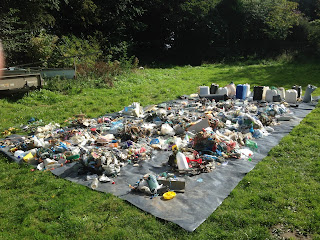Back in August, Beans Boat Trips noticed a branded Common Seal hauled out on Blakeney Point. With some help from the Sea Mammal Research Unit, it was finally traced. Named Yvonne, she was taken in by a German seal rescue centre at the age of three months in June 1995. She was released in September that year (20 years ago), having tripled in weight. Note that branding ceased in 1998, they are now fitted with tags on their back flippers instead.
Yvonne on Blakeney Point (Jason Bean)
The seal ferry trips run by Beans and Temples are the perfect way to enjoy watching seals in their natural environment.
We conducted our latest low tide seal count on Tuesday (15th), recording 766 Grey and 157 Common. It is normal to see a decrease in Common numbers and increase in Greys at this time of year.
This summer we recorded a peak count of 431 Common Seals (on the 17th of August), which is actually the highest count since August 2011 and the first time our low tide count of Commons has exceeded Greys in as many years. When the National Trust first began fortnightly counts in 2005, there were far less Greys - the graph below shows how the annual average number of seals has changed in 11 years of monitoring.

This graph was produced from data collected by E. Stubbings, A. Tegala and D. Wood
(c) National Trust
This week has been one of great transition in terms of migrant birds. We have seen an overlap of birds arriving and departing. It has been nice to see and hear several Sandwich Terns on passage, on their way to West Africa - in amongst them have been the occasional Common and Black Tern. Dozens of Swallows have also been seen on passage, along with a couple of House Martins. We have also seen an increase in wintering wildfowl, with Monday's monthly wetland bird count recording numerous Teal, Wigeon, Mallard and Brent Geese. On Thursday (17th) 38 Pintail were seen arriving and the first Goldcrest of the autumn was heard.
The migrant bird highlight of the week, however, was undoubtedly this juvenile Red-backed Shrike, that spent two days feeding on moths and bees in the garden.
Juvenile Red-backed Shrike eating bee (Richard Porter)
Yesterday we held our annual litterpick on the Point for the Marine Conservation Society's Great British Beach Clean. The weather held out and we were joined by 28 willing helpers, enabling three miles of beach to be cleaned, resulting in 42 bin bags full of rubbish. People came from Blakeney, Holt, Norwich, Sandringham and as far away as Bedford, Leicester and even Yorkshire. A big thank you to all who helped. Our next beach clean will be in late March ahead of next year's breeding bird season.
A good morning's work
Wigeon and Teal aren't the only ducks arriving on our shores!
- Ajay




















































